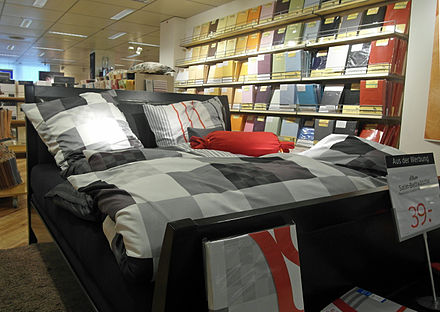
Bedding, also called bedclothes[1] or bed linen, is the materials laid above the mattress of a bed for hygiene, warmth, protection of the mattress, and decorative effect. Bedding is the removable and washable portion of a human sleeping environment. Multiple sets of bedding for each bed are often washed in rotation and/or changed seasonally to improve sleep comfort at varying room temperatures. Most standardized measurements for bedding are rectangular, but there are also some square-shaped sizes, which allows the user to put on bedding without having to consider its lengthwise orientation (e.g. a 220 cm × 220 cm (87 in × 87 in) duvet).
In American English, the word bedding generally does not include the mattress,[2] while in British English it often does.[3] In Australian and New Zealand English, bedding is often called manchester,[4] especially in shops. Manchester was a center of the cotton industry in the late 18th and the 19th century, and into the 20th century, and so cotton goods (principally sheets and towels) were given the name 'Manchester goods', which later was simplified to 'manchester'.
A set of bedding generally consists of at least flat or fitted bed sheet that covers the mattress; a flat top sheet; either a blanket, a quilt, or a duvet. Sometimes with a duvet cover is to be used in addition to or instead of – the top sheet; and a number of pillows with pillowcases, also referred to as pillow shams. (See § Terminology for more info on all these terms.) Additional blankets, etc. may be added to ensure the necessary insulation in cold sleeping areas. A common practice for children and some adults is to decorate a bed with plush stuffed animals, dolls, and other soft toys. These are not included under the designation of bedding, although they may provide additional warmth to the sleeper.

Lightweight white, solid-color or printed plain weave, satin weave, or flannel cotton or cotton/polyester blends are the most common types of sheeting, although linen and silk may also be used, including in combination. Goose or duck down and other feathers are frequently used as a warm and lightweight filling in duvets, comforters and quilts. But such fill can protrude in part even from tightly woven fabric, and be an irritant for many people, particularly those with allergies. Natural and synthetic down alternatives are marketed. Cotton, wool or polyester batting is commonly used as fill in quilts and down alternative comforters. These are less expensive and more easily laundered than natural down or feathers. Synthetic fibers are best in the form of thermofused (where fibers cross) batting. Thick-woven or knitted wool, cotton, acrylic or other microfiber synthetics, or blends of these, are typically used for blankets. The fabric produced from the cotton warp and weft, cotton warp and lyocell weft has a significant improvement in all manner and is best suited for making bed linen.[5]
Among the earliest discovered examples of bedding are remnants found in a Paleolithic structure at Ohalo II, Israel. Dating back 23,000 years, these remnants consist of partially charred stems and leaves positioned on the floor surrounding a central hearth. Potential earlier evidence of bedding, dating from the Middle Paleolithic, is evident in Spain's Esquilleu cave, displaying the gathering of grass near a hearth.[6]
Around 3400 BC Egyptian pharaohs had their beds moved off the ground and slept on a raised surface. Bed linen was widely evolved in Egypt. It was seen as a symbol of light and purity, as well as a symbol of prosperity. The Egyptian mummies were often wrapped in bed linen. The complexity of applications has increased with research and developments in the area of bed linen materials over the years.[5]
Roman Empire mattresses were stuffed with wool, feather, reeds or hay. The beds were decorated with paint, bronze, silver, jewels and gold. Interestingly, it was rare for a Roman couple to spend the night together. It was more common for each spouse to have a separate room. Researchers believe that the Roman bed was definitely less comfortable than today.[7]
During the Renaissance, mattresses were stuffed with straw and feathers and then covered with silks, velvets or satin material. Embroidered canopies and ornamental hangings as well as the advent of the featherbed led to beds becoming extremely expensive, often willed down from generation to generation.[8]
In the 18th century, Europeans began to use bed frames made from cast iron, and mattresses that were made of cotton. Until that time, assorted vermin were simply accepted as a component of even the most royal beds.[9]
In the 19th century the bed spring was invented, also called the box spring.[10]
In the 20th century United States, consumers bought the inner spring mattress, followed in the 1960s by the water bed (originating on the West Coast), and adoption of Japanese-style futons, air mattresses, and foam rubber mattresses and pillows.
Bedding sizes are made with consideration of the dimensions of the bed and mattress for which it is to be used. Bed sizes vary around the world, with countries having their own standards and terminology.